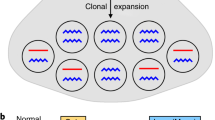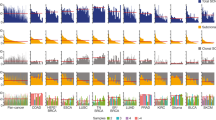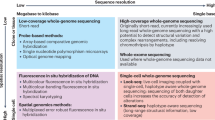Abstract
We have used polymerase chain reaction (PCR) analysis to study the incidence of allelic imbalance at four polymorphic microsatellite markers on chromosome 6q25.1-27, three dinucleotide repeats and one trinucleotide repeat, for microdissected tumour foci from a group of 75 'early' breast carcinomas. The tumours comprised 16 preinvasive cases of ductal carcinoma in situ (DCIS) and 59 mammographically detected early invasive carcinomas. Loss of heterozygosity (LOH) was detected at all four loci and in all types and grade of disease. The frequency of LOH ranged from 23% to 50% depending on the marker studied. The highest frequency of LOH was observed at the D6S186 locus for the cases of DCIS and at the oestrogen receptor locus for the invasive carcinomas. These data suggest that the inactivation of tumour-suppressor genes within this region on chromosome 6q is important for the development of these early lesions.
This is a preview of subscription content, access via your institution
Access options
Subscribe to this journal
Receive 24 print issues and online access
$259.00 per year
only $10.79 per issue
Buy this article
- Purchase on Springer Link
- Instant access to full article PDF
Prices may be subject to local taxes which are calculated during checkout
Similar content being viewed by others
Author information
Authors and Affiliations
Rights and permissions
About this article
Cite this article
Chappell, S., Walsh, T., Walker, R. et al. Loss of heterozygosity at chromosome 6q in preinvasive and early invasive breast carcinomas. Br J Cancer 75, 1324–1329 (1997). https://doi.org/10.1038/bjc.1997.224
Issue Date:
DOI: https://doi.org/10.1038/bjc.1997.224
This article is cited by
-
Matricellular CCN6 (WISP3) protein: a tumor suppressor for mammary metaplastic carcinomas
Journal of Cell Communication and Signaling (2018)
-
MicroRNA-30a suppresses breast tumor growth and metastasis by targeting metadherin
Oncogene (2014)
-
Down-regulation of miRNA-30a in human plasma is a novel marker for breast cancer
Medical Oncology (2013)
-
MicroRNA-30a inhibits cell migration and invasion by downregulating vimentin expression and is a potential prognostic marker in breast cancer
Breast Cancer Research and Treatment (2012)
-
On how CCN6 suppresses breast cancer growth and invasion
Journal of Cell Communication and Signaling (2012)



